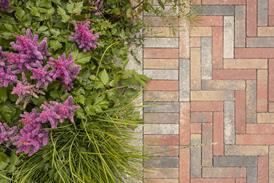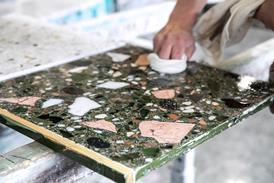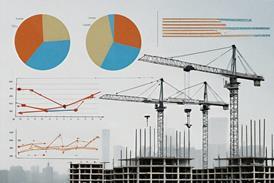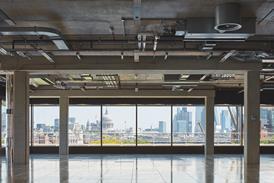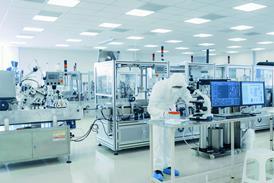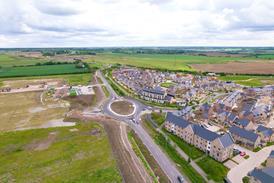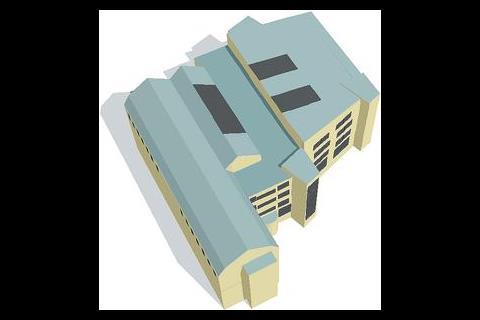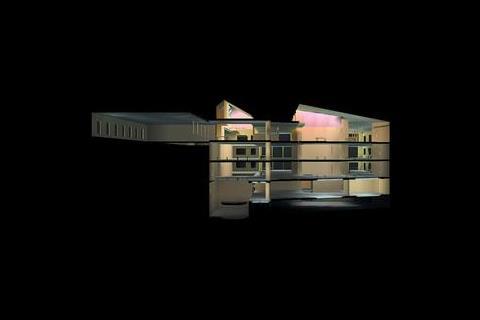The objective has been to use feedback information generated by the PROBE team building investigations to assist the designers in avoiding some of the chronic shortcomings that afflict many new buildings.
Details of the scheme appeared in the October 2000 edition of Building Services Journal 1, and readers are urged to revisit that article as it underpins many of the issues raised here.
The project has evolved considerably since the first PROBE visit. The layout and use of the new building (and the adjacent administration block, Britannia Mill) have altered to meet the client's changed requirements. That said, design has proceeded relatively slowly while the client secures the necessary funds. As a consequence the works will be split over four contract packages:
- Phase 1: site clearance and enabling works, construction of new substation.
- Phase 2: decommissioning of the existing central boiler house and the provision of temporary heat raising plant, site clearance, piling, and excavation for drains etc
- Phase 3: construction of new building (main contract) plus new roof and windows for Britannia Mill
- Phase 4: refit of Britannia Mill.
Several areas of the proposed building have changed from the scheme design. The planned cinema has been removed as it was deemed to be less than fundamental to the School. However, a separate facility will probably be constructed as an independent, free-standing pavilion to the east of the new School.
As a consequence it was possible to raise the basement level (where in any case there would have been ground water problems) to become a lower ground floor. A mezzanine floor will also no longer be needed. The lost accommodation has been relocated to the top floor.
The (new) lower ground floor is still a complex area, although much simpler than the earlier scheme. The layout now contains:
- a tiered lecture theatre
- a level multi-purpose space
- a large multi-purpose lecture/performance space with a combination of flat, tiered and bleacher seating
- toilets, changing rooms, and shop and "green" room
- foyer areas for circulation, intermission gatherings, exhibition space and general seating
The simpler ground floor has allowed all the ventilation plant for the new building to be in a plantroom at the north-east corner of the upper ground floor. From JPA's perspective, centralised plant may mean longer runs, but it also means ease of maintenance and less likelihood of odd items of plant being "fitted and forgotten".
The spatial restructuring has allowed the building's internal voids to be extended to the lower ground floor. Daylight analysis using Lightscape suggests a meaningful daylight contribution to all floor levels, aided by the arched slab, the generous 3·1 m (min) floor to ceiling height (figure 1) and white painted surfaces around the lightwells.
The upper floors are very simple and virtually identical. Deep-plan studio space surrounds two voids: one, to the east, in the middle of the new building, and the other, to the west, effectively a cut-out where the new building abuts Britannia Mill (figure 2).
As in the earlier scheme1, the eastern void is split into two by a central core of toilets, ventilation risers, IT rooms and wash-up areas. As the building is largely one big artists' studio, it is fair to assume that the usual messy cocktail of artistic substances, such as paint and plaster, will be used liberally. Good washing facilities were therefore high on the design agenda.
A closer look at the floor plan suggested that, once circulation was taken into account along with the creation of studio spaces on a 3 m grid, certain spaces might be tight. For example, the east extension to the core could form a pinch point with escape stair 2, which could reduce the amount of usable space.
Similarly, the doors to the washdown and computer rooms could be repositioned, as their current locations create oddly shaped spaces which might have less functionality than the floor plan suggests. The PROBE Team were also concerned at the lack of pre-defined on-floor storage, often a cause of occupant dissatisfaction.
The east wall is also at an angle to the arched slabs, and this suggests that the ceiling at this point might be easier to construct as a flat slab (the grey shaded area in figure 2). If so, users might treat this area differently to the other studio space. On the first floor this area has access to a narrow external balcony (not shown), and it was suggested that this area could be nominated as a relaxation area.
Having said that, it was thought that the balcony on the north elevation could be a security hazard as it is less visible to passers-by. It was suggested that it could be justifiably removed as a cost-saving measure.
Daylighting and glazing
The original design had been highly glazed with the potential for high solar gain. Their aim had been to reduce the glazed area to 30%, and a combination of solar glass and opaque insulated panels has achieved this.
While 30% glazing is a worthy target for striking a balance between daylighting and solar gain, over-zealous pursuit of this objective can lead to expanses of structural facade.
The PROBE Team commented that the glazing areas are now quite far apart, with big gaps at the escape stairs. Some more glass could also be added to the north side without risk of causing glare or overheating.
The PROBE Team was cautious about the glass transmission and floor reflectance values used in the Lightscape simulations. The proposal for ad hoc studio screens would cut down the light further. In addition, it was noted that much of the glass in the existing building had been covered up by staff and students.
While there is clearly the potential for good daylight, the PROBE Team suggested the predictions be reviewed and the lighting control scheme developed to take account of the screening which might occur. Otherwise the lights might default to on.
The current design has planar glazing for the ground-floor south-facing entrance, which also rises to the studio floors above. While this approach is defensible for entrance areas, buildings with similar features have demonstrated that high expanses of glass create fragile comfort zones, with glare and solar gains conspiring to cause occupant dissatisfaction in work areas.
The problem is analogous to the large glazed main entrance at the headquarters of Charities Aid Foundation. This also rises to first floor (office) level2. Occupants complained about the large glazed area, the solar gain, and the absence of openable windows.
At Derby, the PROBE Team was not sure why planar glazing was essential, particularly as the detailing changes at first floor level. Similarly, the planar glazing on the north elevation seemed rather monumental for what is essentially a rear entrance. JPA will try and cajole the architect into using glazing-faced spandrel panels to reduce the solar gain problems without the building losing any aesthetic appeal.
Window openings
The window design at the School of Art & Design is ongoing, and currently only high-level centre-pivot windows are being used.
The PROBE Team's observation was that while centre-pivoted windows can be good, they can interfere with curtains and blinds. Friction mechanisms can also loosen or be wrongly lubricated.
In debate with the designers, it was agreed that some motorised clerestory windows would be good for night ventilation, with some manually openable windows below for occupant use. If internal shading was used, some form of robust shuttering might be appropriate.
Electric lighting and controls
JPA has a good track record in designing passive solar buildings, and knows from experience how mercurial lighting controls can be. Despite having designed a very simple lighting controls system for the Learning Resource Centre3 at Derby University, JPA found it almost impossible to get the equipment to work properly, even after a major effort by the manufacturer.
The main challenge on this project is the studio lighting. The design team is minded to use suspended service trunking with fluorescent up/downlighters slung beneath the crown of each arched span (ie at 3 m centres). The PROBE lighting control guideline – manual on and automatic, occupancy-sensed off – will be followed.
Despite such control, lighting can still be wastefully on in public and circulation areas. The PROBE Team therefore recommended careful design of low energy circulation lighting. The control system should be effective enough to ensure it is off when daylight is available, and reduced to a minimum when the building is shut.
JPA is aware that the studios could look gloomy at night, causing lights to stay on more than necessary. The PROBE Team suggested the visual environment could be improved by illuminating some vertical surfaces (particularly the cores and staircases) with efficient light sources.
The PROBE Team warned that these lamps should not be regarded as part of the building's main feature lighting and therefore not left on unnecessarily. For these reasons JPA will give specific instructions to the tenderers.
In terms of the studios, debate centred on how to divide up each 12 m long and 3 m-wide bay. Most bays start at a lightwell and end at a window. The PROBE Team suggested reset pull-switches with absence detection (say, a 15 minute delay) for each fitting, plus daylight linking at the perimeter. JPA thought this too expensive, so a practical alternative was suggested:
- three luminaires on each pull-switch, plus
- luminaires near voids and windows also daylight linked (but able to be disconnected when the windows are legitimately blacked-out)
Mechanical services
The building's heating systems will be replaced by three low-Nox boilers, two of which will be condensing. Perimeter radiators will have thermostatic control valves for local trimming. The PROBE Team commented that all controls should have robust, tamperproof heads but with no user adjustment in corridors and wcs, and only limited adjustment in student areas.
JPA has proposed low flush wcs, waterless urinals and timed, blended-water spray taps for hand-wash basins. This seemed a good proposal, although the PROBE Team felt that it was a pity to provide hot water irrespective of whether it was needed. It is a British obsession to have hot water available at all taps when the convention in other countries is to use only cold water. The PROBE Team believe that a national discussion of hot water provision is needed to identify the best balance between hygiene requirements and energy conservation.
Water heating is currently based on self-contained gas-fired units for the kitchen and photography areas, and local electric water heaters elsewhere. The PROBE Team suggested a single gas-fired condensing water heater for the toilets and wash-up areas.
Ventilation
With the simplified planning, mechanical ventilation is only needed in the toilet cores and the three main lecture/performance theatres. These will be independently controlled with local on-demand actuation to suit the varying needs of the different spaces. The other multi-purpose space will be on-demand extract only.
The PROBE team mentioned the need to minimise specific fan power levels in the air handling units. JPA had yet to get to this level of detail, but will be using CIBSE's TM22 energy-tree analysis to keep track of their energy predictions and to identify and communicate the most important items. The firm is familiar with this process, having achieved low fan power levels in Derby's Learning Resource Centre.
The rest of the building is naturally ventilated, predominately on a sides-to-centre basis. The rooflights over the voids will be the point of extract, along with some automated perimeter windows to enable a night-purging strategy to be adopted.
Much debate centred on the south and east-facing mono-pitch roof and the inability of extract vents to benefit from negative pressure zones which would otherwise be created by an M-shaped ridge design (as used by JPA for the Learning Resource Centre).
The top floor of the roofspace of the existing mill building will be fitted with new Velux windows and low and high level to permit cross and stack ventilation. The current design (figure 2) shows this floor linked to the void between the old and new buildings. The PROBE Team commented that this would be in the zone of the hot air reservoir at the top of the void, and indeed JPA has already suggested to the design team that a visual connection between the two spaces would be better from the standpoint of both thermal comfort and fire protection.
Thermal simulations had been carried out using the Tas program. These tests concentrated on temperatures on the third floor and showed that the target of 5% of occupied hours above 25°C and 1% above 28°C was achievable. The PROBE Team wondered if the temperatures on the south side might be higher.
JPA is considering higher-performance glass provided it does not skew the colour spectrum in the studios. A system of fireproof fabric sails is also being considered to intercept solar radiation, improve daylight penetration and help drive stack ventilation. Such devices can have revenge effects however, they can intercept cross-ventilation and create "downwashes" of hot air, while scattering daylight or cause unwanted chinks of glare. While this might not disturb studio artists, it might affect users of computers which are intended to be located around the perimeter of the voids.
The PROBE Team advocated more work on the details of the rooflight to include daylight and solar gain characteristics. Possibilities included a northlight orientation and a lightweight, inflated ethylenetetrafluoroethylene (efte) foil roof5. The latter might obviate the need for sails (although it could also reduce daylighting on overcast days).
Computer tests carried out by JPA on a different roof profile demonstrated the potential benefits to daylighting and solar control, but at this stage it may be very costly to change the structure and orientation. As experienced engineers JPA will aim to adopt the best balance, which may still mean the use of active components.
What this study means for you
Budget for simulationsBe wary of results of computer simulations based on bare details. Iterations are always required to check that the assumptions used in the initial computer runs remain valid when details, such as mass factors or daylight obstructions, are added. It is rare in low-energy academic projects for enough to be in the budget for multiple runs. Sell sea-trials to clients
John Packer Associates had the foresight to write a clause in its standard conditions covering the first year of occupation: “Attend site on four occasions in the first year of occupation of the building to check, with the building facilities team, the operation of the services systems and the satisfaction of the occupants.”
All lighting matters
PROBE studies have revealed that efficient control of electric lighting in atriums, circulation and other spaces is often not appreciated. A common error is giving main reception desks control over feature lighting that they cannot see. More of this lighting needs to be under the control of daylight sensors, with local manual override where necessary.
Cut problems at root
The services profession often tries to alleviate inherited problems rather than push to remove them at source. Here, the roof profile and rooflights could be designed by the architects to reduce solar gains and improve daylighting and ventilation, rather than force engineers to adopt solutions – such as light reflecting sails – that might introduce new problems.
Commissioning client:
Estates Management Department, University of Derby
User client:
School of Art and Design, University of Derby
Architect:
David Lyons & Associates
Building services engineers:
John Packer Associates
Structural engineer:
Alan Brough & Associates
Quantity surveyor:
Rex Procter & Partners
PROBE Team advisors:
Bill Bordass, Adrian Leaman, Roderic Bunn
Downloads
Figure 2
Other, Size 0 kb
Source
Building Sustainable Design
Reference
References
1 Bordass W & Leaman A, `School of Art & Design 1', Building Services Journal 10/2000
2 PROBE 13: Charities Aid Foundation, Building Services Journal 2/98
3 Field J & Pearson A, `Natural aspiration', Building Services Journal 2/98
4 BRE Information Paper IP6/96: People and lighting controls
5 Morris B, `The bubble-wrapped atrium', Building Services Journal, 7/92.
Postscript
The PROBE Team for this study was Dr Bill Bordass, principal of WBA, and Roderic Bunn of BSRIA.











